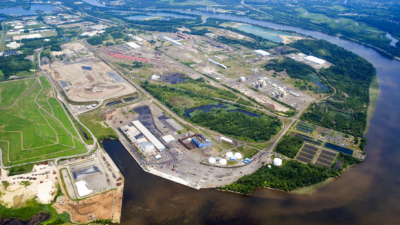U.S. occupier activity in bulk industrial space (greater than 100,000 square feet) outpaced 2018 transaction volume by 12.3% and totaled more than 420.4 million square feet at the end of 2019. A total of 1,755 industrial (warehouse, manufacturing, and flex) new leases, renewals and user sales were transacted in 2019, despite 2019 net absorption of 239.8 million square feet — trailing in both 2017 and 2018, where net absorption totaled 269.7 million square feet and 291.2 million square feet, respectively. The average size of a bulk transaction was roughly 240,000 square feet, much lower than the 266,000 square feet average this time last year.

Third-party logistics and packaging companies (3PLs) remained the top occupier of bulk industrial space in 2019, although market share for the industry decreased to 25.1%, down from 30.8% of all bulk space transacted one year ago. 3PLs, who offer logistics and warehousing services for retailers and wholesalers who choose to outsource, remain the top occupier of industrial space for a variety of factors including cost savings for retailers and wholesalers. While 3PLs were the top overall occupier, the data centers/tech/R&D industry more than doubled its space occupied in 2018 and inked 12.8 million square feet in 2019.

Amazon, once again, topped the list of bulk occupiers in the U.S., filling 17.7 million square feet in 2019, including a 2.6 million-square-foot fulfillment center in Oklahoma City, OK. While still high, this marks an 8.8% decline from the 19.5 million square feet Amazon occupied in 2018. E-commerce-only occupiers accounted for just 9.2% of transactions in 2019 and the average size of an e-commerce transaction was 423,319 square feet in 2019, down 9.8% from the average size of 469,243 square feet last year. Amazon has held the title of the top e-commerce company and overall occupier of industrial space since 2014, occupying an average of 17.6 million square feet each year. FedEx claimed the second spot, with 4.2 million square feet transacted in 12 transactions in 2019.

Transactions in the Midwest accounted for 33% of all bulk occupier activity, followed by the Southeast with 25%. The Southcentral market was the slowest in 2019, accounting for just 10% of transactions signed. The Midwest continues to attract industrial users for its significant transportation and logistics advantages. Population and labor growth continue to fuel activity in the Southeast region, while the West region remains in third, thanks to continued strong demand in the Inland Empire, which remains one of the top markets in the country for bulk leasing activity.

Transaction volume for bulk industrial space is expected to remain stable over the next 12 months, despite projected headwinds to economic fundamentals, including persistent trade tensions with China, and the outbreak of COVID-19 (coronavirus) — the impact of which remains largely unknown. While 3PLs continued to dominate activity in 2019, general retail and wholesale business increased 52.1% year over year to reach more than 20% of activity for the first time since 2015, accounting for 23.7% of transaction volume. These two industries account for nearly half of all bulk occupier activity over the last 12 months. We expect these industries to remain in the top spots, as many of these occupiers continue to expand and modernize their distribution and manufacturing networks. Occupiers will continue to focus on industrial product in the Midwest to optimize their omnichannel strategies, and population growth will keep occupiers in all industries interested in space in the Southern and Western portions of the U.S. Near-record levels of industrial product under construction, driven by low vacancy and strong demand, will continue to offer modern options for bulk occupiers in the coming quarters.
Company Type Description:
Construction, Improvement and Home Repair – Warehousing and distribution of materials used in residential and commercial construction, improvements and repair, could contain some e-commerce components.
Data Centers, Tech and R&D – The use of industrial space for data centers and non-pharmaceutical R&D purposes.
E-Commerce Only – Warehousing and distribution of product that is ordered online and shipped directly to the end consumer only.
Food, Beverage and Pet Supply – Manufacturing, warehousing and/or distribution of food and beverage related products. Could contain some e-commerce or manufacturing components.
Furniture and Appliances – Warehousing and distribution of retail and/or wholesale furniture and appliance products. Could contain some e-commerce and or manufacturing components.
General Retail and Wholesale – The warehousing and distribution or retail and/or wholesale products not listed in any of the other categories. Could contain some e-commerce or manufacturing components.
Manufacturing – Industrial space used for manufacturing and/or storage of raw materials and equipment used in the manufacturing of non-automobile related products.
Motor Vehicles, Tires and Parts – The warehousing, manufacturing and/or distribution of motor vehicles, tires, and related parts and materials.
Third-Party Logistics and Packaging – Third-party logistics and packaging of a wide variety of products, could contain some e-commerce components.
About the Author:
Amanda Ortiz is the Director, National Industrial Research on the National Marketing & Research team at Colliers. Based in Chicago, Amanda partners with national and local teams to deliver market intelligence initiatives and provide direction to drive national competitive advantage through research strategy, development and analytics.

 U.S. National Research
U.S. National Research
 Craig Hurvitz
Craig Hurvitz
 Lauren Pace
Lauren Pace Ronna Larsen
Ronna Larsen
 Tom Golarz
Tom Golarz Michael Golarz
Michael Golarz